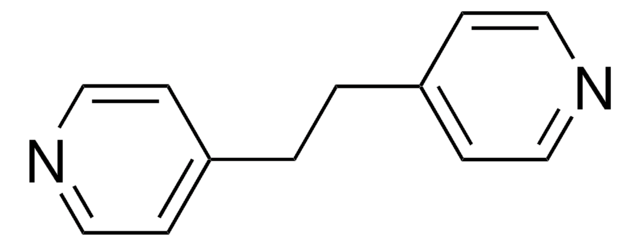B52808
1,2-Di(4-pyridyl)ethylene
97%
Synonym(s):
1,2-Bis(4-pyridyl)ethylene, 4,4′-Vinylenedipyridine
About This Item
Recommended Products
Quality Level
Assay
97%
form
crystals
mp
148-152 °C (lit.)
SMILES string
c1cc(ccn1)\C=C\c2ccncc2
InChI
1S/C12H10N2/c1(11-3-7-13-8-4-11)2-12-5-9-14-10-6-12/h1-10H/b2-1+
InChI key
MGFJDEHFNMWYBD-OWOJBTEDSA-N
Looking for similar products? Visit Product Comparison Guide
Related Categories
Application
- Expanding and shrinking cadmium-based pillared layer coordination polymers showing selective guest adsorption.
- Dinuclear zinc complex that exhibits photocontrolled fluorescence.
- Platinum-based 3-D tetragonal prisms via multicomponent coordination-driven self-assembly.
Signal Word
Warning
Hazard Statements
Precautionary Statements
Hazard Classifications
Eye Irrit. 2 - Skin Irrit. 2 - STOT SE 3
Target Organs
Respiratory system
Storage Class Code
11 - Combustible Solids
WGK
WGK 3
Flash Point(F)
Not applicable
Flash Point(C)
Not applicable
Personal Protective Equipment
Certificates of Analysis (COA)
Search for Certificates of Analysis (COA) by entering the products Lot/Batch Number. Lot and Batch Numbers can be found on a product’s label following the words ‘Lot’ or ‘Batch’.
Already Own This Product?
Find documentation for the products that you have recently purchased in the Document Library.
Our team of scientists has experience in all areas of research including Life Science, Material Science, Chemical Synthesis, Chromatography, Analytical and many others.
Contact Technical Service









